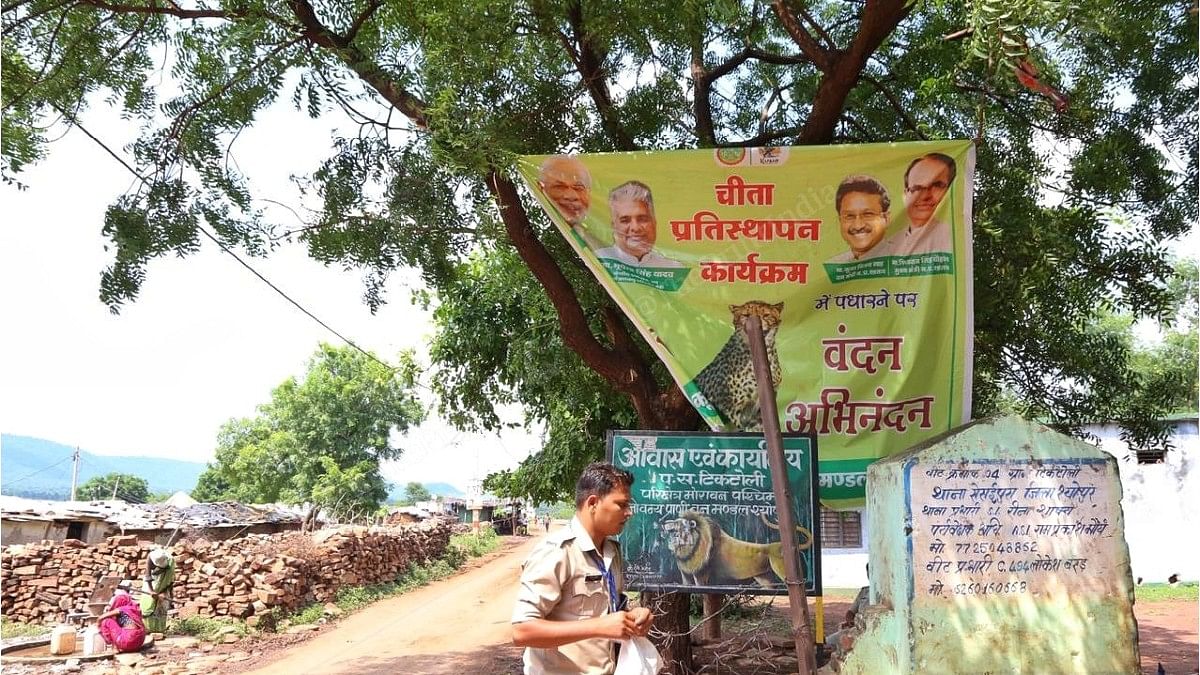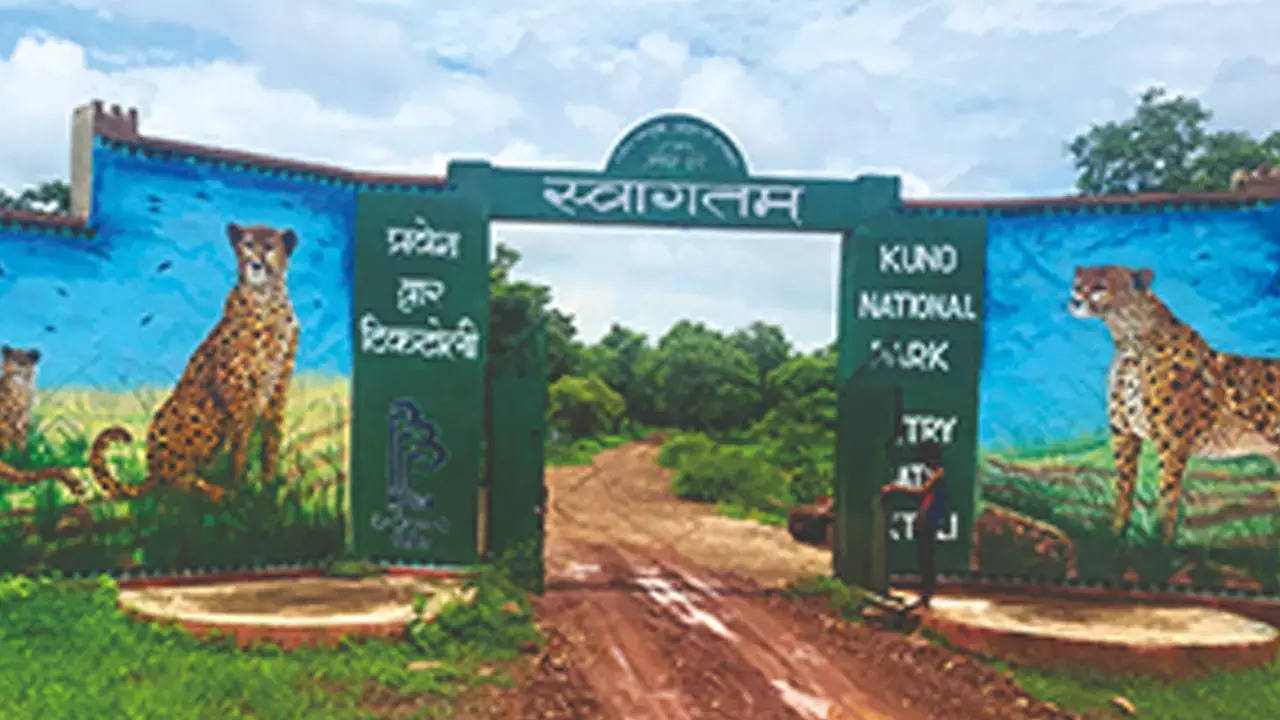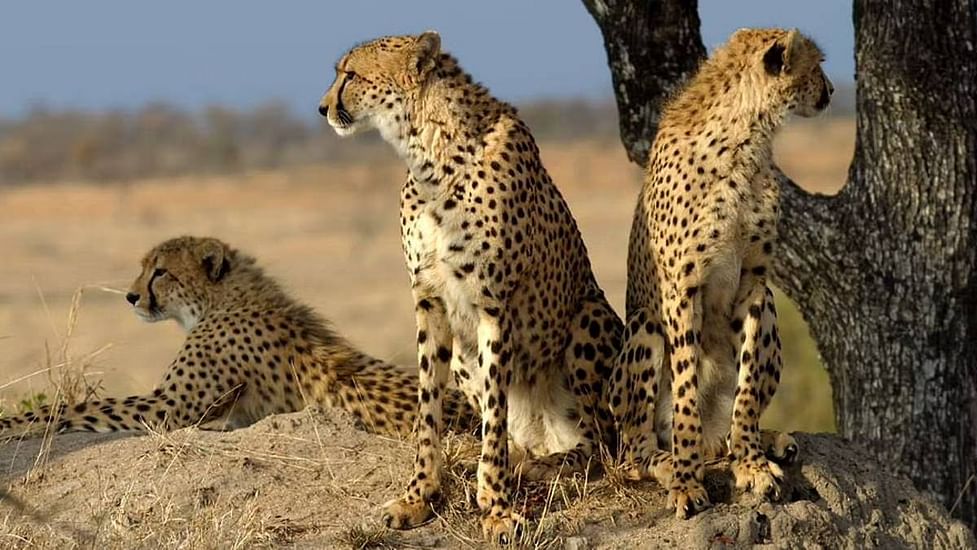“Rewilding difficult on Cheetahs”- Challenges in sustaining animals begin at Kuno

Specialists and forest staff will be on the lookout for illness and whether or not cheetahs approach food. The wild cats must adapt to their new environment and learn the habits of their new prey.
The team of experts from South Africa and Namibia told ThePrint that the eight newly translocated cheetahs from Namibia were “freaked out” by the hundreds of people at Kuno when they were released but that they have since calmed down and are adjusting well.
“It had been well over 24 hours by the time we were able to release them, so they were relieved to stretch their legs and get out.” “But they were also frightened because there were so many people,” Laurie Marker, executive director of the Cheetah Conservation Fund, said. These were wild animals attempting to flee from onlookers. We therefore had to attempt crowd control and ask people to move back. Hundreds of people, including politicians, state and district administrators, forest staff, police, and “cheetah mitras,” who were recruited from nearby villages to spread awareness about the behavior of them, witnessed Prime Minister Narendra Modi’s release of the cats into quarantine enclosures on Saturday.
The program was the culmination of decades of work dedicated to resurrecting the predators in India, where it was declared extinct in 1952. The plan has divided conservationists worldwide, with many believing that the risks of introducing a vulnerable species to a new environment outweigh the benefits.
Getting used to their new surroundings- Cheetah
The animal traveled nearly 30 hours to Kuno National Park, a journey that can be hazardous due to stress-related mortality, according to South African veterinary wildlife specialist Adrian Tordiffe.

“Stress has a variety of negative effects. “They actually did extremely well. “To keep the cheetahs calm, they were given a psychoactive drug that is used to treat schizophrenia in humans but works well as a sedative in cheetahs. The wild cats have satellite collars that will track their movements once they are released from quarantine.
Aside from a new environment, the cheetahs will need to learn how to effectively hunt their new prey base.
According to Tordiffe, the cheetahs’ fitness levels may decline while in quarantine and in the enclosures, necessitating supplementation.
Upcoming difficulties
“Even if there were 5,000 square kilometers free of leopards, domestic dogs, and humans, it would not be enough for the animal.” A natural population requires 10,000 square kilometers or more.” “Even with tougher species like tigers, which can reach densities of 10-15 per 100 square kilometers, only one in Panna has resulted in a successful, viable breeding tiger population, due to massive village relocations that preceded it,” he added.
To save the species from extinction, Marker believes that risks must be taken. There are fewer than 7,000 adult cheetahs left in the wild, and they now occupy less than 9% of their original range.
It’s difficult for those involved in rewilding and rehabilitation. It’s also very difficult on the various animals. She said, “Ideally, it is better not to let an animal go extinct.”
India is negotiating with South Africa to import 12 more cheetahs by the end of the year. According to government officials, South Africa is expected to sign an agreement in the coming weeks.
According to veteran conservationist M.K. Ranjitsinh, whose vision of reintroducing the cheetah is central to the program, more planning is needed before the next batch of them arrives.
“Cheetahs roam. He predicts that they will require a larger area with a larger prey base. The government must also guarantee prompt payment of compensation. This will reduce reprisals, but it might also increase locals’ awareness of and respect for the cheetah’s behavior.
Seventy years after going extinct, cheetahs are making a comeback to India as part of the largest conservation trial in history.
For the pilot project, eight Namibian cheetahs were carefully selected. They will be kept in isolation and enclosed before being released into Kuno National Park.
Celebrations erupted outside Madhya Pradesh’s Kuno National Park on Saturday as Prime Minister Narendra Modi released eight predators from Namibia into their enclosures, reintroducing a species that went extinct in India 70 years ago.
The relocation program, which has been in the works for decades, is the first and largest trans-continental conservation experiment of its kind, with the goal of reintroducing the mammals to its former range.
According to the government, the goal is to create metapopulations — groups of spatially separated populations — to help conserve India’s dwindling grass ecosystems.
On Saturday, Prime Minister Modi urged the general public to “be patient” and “wait a few months” before seeing the cheetahs in Kuno. He also thanked the Namibian government for its participation in the pilot project.
“We will have to give them a few months to be able to make Kuno National Park their home,” said the Prime Minister, who celebrated his 72nd birthday today.
In 2009, Indian conservationists and the Namibia-based non-profit Cheetah Conservation Fund (CCF) proposed ‘Project Cheetah,’ which was approved by the Supreme Court as a pilot project in January 2020. In this regard, a Memorandum of Understanding (MoU) was signed in July 2020 between India and the Republic of Namibia.
Travel to India
The eight predators were loaded onto a customised B747 jet at Namibia’s capital Windhoek’s Hosea Kutako International Airport on Friday and flown approximately 11 hours overnight to Gwalior.
They were then helicoptered to the Kuno Palpur National Park. “I’m excited and nervous, but also optimistic,” Dr Laurie Marker, executive director of the Cheetah Conservation Fund (CCF), told ThePrint before boarding the flight in Windhoek.
Marker went on to say that the big cats were “mildly tranquilized” for the trip. Cheetah specialists Eli Walker and Barthelemy Balli, as well as veterinarian Dr Ana Basto, were also on the flight.

The cheetahs, five females and three males, are all wild adults ranging in age from two to five and a half years and have lived alongside leopards, according to Dr. Marker. Four of the cats are from Namibian private reserves.
According to CCF, each cheetah was chosen with care based on its health, temperament in the wild, hunting prowess, and capacity to “contribute genes that would result in a strong founder population.”
Namibia and South Africa will add four or five cheetahs to the population every year for at least five years to diversify gene flow.
South Africa has yet to sign a formal translocation agreement. Experts from South Africa will submit a report to the government in Kuno based on their assessment during a two-day visit from September 6-8, after which an agreement with India will be formalized.
‘It will take months to adjust.’
Dr. Marker told ThePrint that the cheetahs will need time to adjust to their new surroundings.
According to Kuno National Park forest officials, this process can take several months.
He went on to say that the department “will have to feed them [cheetahs] while they’re in quarantine.”
Each cheetah is immunized against diseases such as canine distemper and fitted with a satellite collar to allow for constant monitoring.
They will only be released into the 748-square-kilometer national park after demonstrating sufficient confidence within the 600-hectare enclosure. “We believe we have enough space for at least one metapopulation because the forest area contiguous with Kuno is 5,000 square kilometers,” Chauhan explained.
According to Namibian and South African experts, the Kuno National Park has a dry and deciduous environment that is suitable for cheetahs.
Several of Kuno’s 400-plus employees have been trained by African experts to monitor cheetahs, and at least one tracker dog has been deployed to track the leopards and cheetahs.

‘Cheetah Mitra,’ mixed feelings
Kuno National Park, which was created to facilitate the translocation of Asiatic lions, is not as well established as nearby reserves such as Ranthambore Tiger Reserve.
The closest forest department rest house to the national park is in Sesaipura, Sheopur district, where forest and district officials were discussing last-minute arrangements and passes for the Saturday event, which was attended by at least 200 people.
However, public perception of cheetahs is one of wildlife authorities’ top priorities. Residents of at least three villages near Kuno believe the leopard population in the park has already increased, as have livestock attacks.
The MP forest department recruited “cheetah mitras” from neighboring villages in an attempt to mitigate any threats to the cheetahs. According to Bharat Singh Gurjar, a “cheetah mitra” from Sesaipura village, “we will have to raise awareness, explain to people the cheetah’s behavior, and coordinate with the forest department if there are any attacks.”
The program is only a week old, and the ‘cheetah mitras’ have received no formal training.
Kalu Adivasi, who lives in a village near Kuno, said locals were concerned that the cheetahs would harm livestock and attack villagers.
However, the relocation of cheetahs has led locals in Sheopur district, where the average literacy rate is 61.32 percent, to believe that the region will benefit from development.
Gopi Adivasi shares this sentiment. He was a Moravan village resident who had sold a portion of his farmland to a local Gujjar family, who then sold it to developers. Locals say a five-star hotel is being built in the area, and Gopi is now working as a laborer on the project.
” This is fantastic news for everyone. “We hope it will bring more jobs,” Gopi’s neighbor Vishnu Gujjar, who also works as a laborer on the project, told ThePrint.





